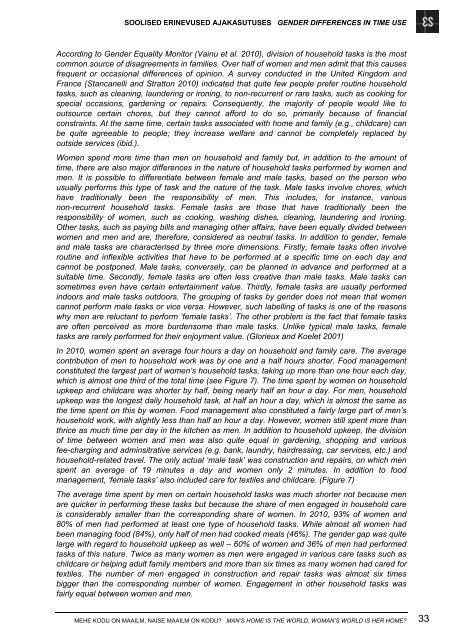MEHE KODU ON MAAILM, NAISE MAAILM ON KODU? - Tartu Ãlikool
MEHE KODU ON MAAILM, NAISE MAAILM ON KODU? - Tartu Ãlikool
MEHE KODU ON MAAILM, NAISE MAAILM ON KODU? - Tartu Ãlikool
You also want an ePaper? Increase the reach of your titles
YUMPU automatically turns print PDFs into web optimized ePapers that Google loves.
SOOLISED ERINEVUSED AJAKASUTUSES GENDER DIFFERENCES IN TIME USE<br />
According to Gender Equality Monitor (Vainu et al. 2010), division of household tasks is the most<br />
common source of disagreements in families. Over half of women and men admit that this causes<br />
frequent or occasional differences of opinion. A survey conducted in the United Kingdom and<br />
France (Stancanelli and Stratton 2010) indicated that quite few people prefer routine household<br />
tasks, such as cleaning, laundering or ironing, to non-recurrent or rare tasks, such as cooking for<br />
special occasions, gardening or repairs. Consequently, the majority of people would like to<br />
outsource certain chores, but they cannot afford to do so, primarily because of financial<br />
constraints. At the same time, certain tasks associated with home and family (e.g., childcare) can<br />
be quite agreeable to people; they increase welfare and cannot be completely replaced by<br />
outside services (ibid.).<br />
Women spend more time than men on household and family but, in addition to the amount of<br />
time, there are also major differences in the nature of household tasks performed by women and<br />
men. It is possible to differentiate between female and male tasks, based on the person who<br />
usually performs this type of task and the nature of the task. Male tasks involve chores, which<br />
have traditionally been the responsibility of men. This includes, for instance, various<br />
non-recurrent household tasks. Female tasks are those that have traditionally been the<br />
responsibility of women, such as cooking, washing dishes, cleaning, laundering and ironing.<br />
Other tasks, such as paying bills and managing other affairs, have been equally divided between<br />
women and men and are, therefore, considered as neutral tasks. In addition to gender, female<br />
and male tasks are characterised by three more dimensions. Firstly, female tasks often involve<br />
routine and inflexible activities that have to be performed at a specific time on each day and<br />
cannot be postponed. Male tasks, conversely, can be planned in advance and performed at a<br />
suitable time. Secondly, female tasks are often less creative than male tasks. Male tasks can<br />
sometimes even have certain entertainment value. Thirdly, female tasks are usually performed<br />
indoors and male tasks outdoors. The grouping of tasks by gender does not mean that women<br />
cannot perform male tasks or vice versa. However, such labelling of tasks is one of the reasons<br />
why men are reluctant to perform ‘female tasks’. The other problem is the fact that female tasks<br />
are often perceived as more burdensome than male tasks. Unlike typical male tasks, female<br />
tasks are rarely performed for their enjoyment value. (Glorieux and Koelet 2001)<br />
In 2010, women spent an average four hours a day on household and family care. The average<br />
contribution of men to household work was by one and a half hours shorter. Food management<br />
constituted the largest part of women’s household tasks, taking up more than one hour each day,<br />
which is almost one third of the total time (see Figure 7). The time spent by women on household<br />
upkeep and childcare was shorter by half, being nearly half an hour a day. For men, household<br />
upkeep was the longest daily household task, at half an hour a day, which is almost the same as<br />
the time spent on this by women. Food management also constituted a fairly large part of men’s<br />
household work, with slightly less than half an hour a day. However, women still spent more than<br />
thrice as much time per day in the kitchen as men. In addition to household upkeep, the division<br />
of time between women and men was also quite equal in gardening, shopping and various<br />
fee-charging and adminsitrative services (e.g. bank, laundry, hairdressing, car services, etc.) and<br />
household-related travel. The only actual ‘male task’ was construction and repairs, on which men<br />
spent an average of 19 minutes a day and women only 2 minutes. In addition to food<br />
management, ‘female tasks’ also included care for textiles and childcare. (Figure 7)<br />
The average time spent by men on certain household tasks was much shorter not because men<br />
are quicker in performing these tasks but because the share of men engaged in household care<br />
is considerably smaller than the corresponding share of women. In 2010, 93% of women and<br />
80% of men had performed at least one type of household tasks. While almost all women had<br />
been managing food (84%), only half of men had cooked meals (46%). The gender gap was quite<br />
large with regard to household upkeep as well – 60% of women and 36% of men had performed<br />
tasks of this nature. Twice as many women as men were engaged in various care tasks such as<br />
childcare or helping adult family members and more than six times as many women had cared for<br />
textiles. The number of men engaged in construction and repair tasks was almost six times<br />
bigger than the corresponding number of women. Engagement in other household tasks was<br />
fairly equal between women and men.<br />
<strong>MEHE</strong> <strong>KODU</strong> <strong>ON</strong> <strong>MAAILM</strong>, <strong>NAISE</strong> <strong>MAAILM</strong> <strong>ON</strong> <strong>KODU</strong>? MAN’S HOME IS THE WORLD, WOMAN’S WORLD IS HER HOME? 33

















